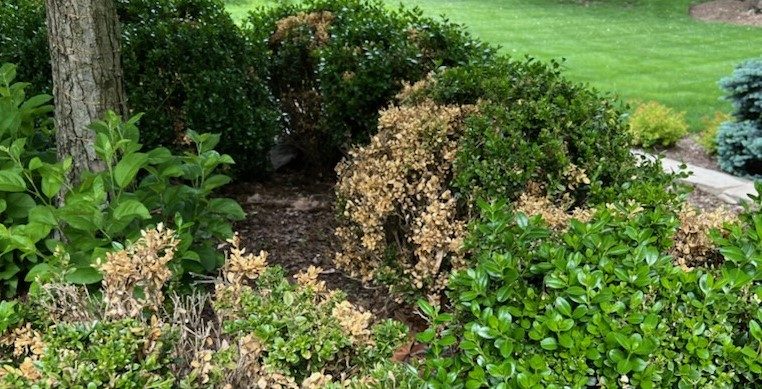Mid to late summer is a good time to scout for environmental or bacterial leaf issues in the landscape. Precipitation declines, the summer heat rises, and drier weather moves in, making it easier to detect underlying root health issues or leaf diseases that can mimic abiotic issues.
Environmental Leaf Scorch
Environmental leaf scorch is an abiotic (non-living) issue that can affect any ornamental (it tends to favor trees such as maple, horse chestnut, beech, oak, and dogwood). It typically occurs during prolonged dry periods and can eventually affect the entire canopy. The leaf scorch symptom spreads from the margins of the outermost leaves, starting on the outer tip and working its way inward, and in extreme cases, the leaf can become fully desiccated. Depending on the severity of the dry/drought period, leaf drop may also occur.

The top two causes are a lack of water and poor root health. In lesser circumstances, too much water or too much nitrogen fertilizer can also cause scorch symptoms. The lack of water can be apparent from a prolonged, dry forecast, and younger plant material will begin to show symptoms well before mature, established trees and shrubs. Poor root health will show similar symptoms even if there has been consistent rainfall or irrigation, and can be caused by a multitude of underlying issues. Girdling roots will also cause these symptoms and typically happen near the trunk of the tree. These can sometimes be seen with the naked eye when one main/large root crosses over another, and as it continues to grow in diameter, it will cut off water and nutrients to the other section of the tree trunk, causing the appearance of water stress and scorch symptoms.

Heat stress can also set environmental leaf scorch in motion. Even when a tree or plant has plenty of water around its roots, high temperatures can cause it to increase transpiration, causing faster water loss in the leaves. Trees that are surrounded by parking lots or other heat reflective surfaces will show leaf scorch symptoms sooner than trees that are surrounded by proper mulching, turf, or other light vegetation.

The best way to combat environmental leaf scorch is to keep up on watering. For areas impacted by drought, a long, deep watering once a week (commonly referred to as infrequent) is an excellent way to help affected trees recover. If there’s a root health issue at play, I recommend a deep root feeding or a root drench using Grow-In and Colonise Bio LTO; this can be done at any time during the year, but is best in spring or fall. Keep in mind that a tree may not get these symptoms every year, and trees can recover after treatment, so there’s no need to prune any branches whose leaves have been affected or defoliated.
Bacterial Leaf Scorch
Bacterial leaf scorch (commonly abbreviated as BLS) is a lethal disease in ornamentals. Oaks are the most common ornamental to be afflicted by BLS, but it’s been detected in over 100 different species. Symptoms first appear in the spring and early summer and typically only affect a few branches at a time. BLS symptoms are almost identical to those of environmental leaf scorch, with the exception of a yellow margin that often appears between the dead and dying brown tissue and undamaged green tissue. These symptoms become more apparent later into summer and mimic environmental leaf scorch.

The causal bacteria is spread by sap-sucking insects that feed on the leaf’s xylem and hop from tree to tree, spreading the disease as they move around. Because it’s a lethal disease, it only takes a few years for an infected tree to die. If you suspect a tree has been infected with bacterial leaf scorch, a sample should be taken and sent to a lab for confirmation.

When it comes to treatment, the first line of defense is to plant non-susceptible trees. Of course, the properties you’re treating already have established ornamentals, so promoting and maintaining overall tree health through cultural practices like fall deep root feeding, proper watering, and pruning infected branches is the best course of action. There are antibacterial injections available, but they’re not a long-term solution; they will simply delay death. If a lab test comes back positive for BLS, the best course of action is to remove the infected tree, since the disease will continue to progress every year until the tree dies and could infect other plants.
Leaf Blotch
A catch-all term for different fungal blotch diseases, the leaf blotch umbrella can include guignardia leaf blotch of horse chestnut, rose black spot, dogwood anthracnose, and septoria or cercospora on hydrangea.
Guignardia leaf blotch is arguably the most common of the three listed, and it affects horse chestnut and buckeye. Symptoms will appear as irregular brown patches, typically with a yellow halo. You may also see black, circular fruiting bodies within the brown area.
The number one way to prevent leaf blotch diseases is through sanitation. Fall leaf cleanup must be thorough since infected fallen leaves can cause reinfection in the spring. Improving air circulation is also important; selective thinning of the canopy during the winter can accomplish this. Fungicides will come in handy, too. Protectant fungicides, such as Manzate Pro Stick T&O and Kalmor, should be applied at bud opening or leaf emergence. In the late spring, curative fungicides like Eagle 2EW, Pageant, and Tourney are the best line of defense.
For additional information, please reach out to your ATS rep.






